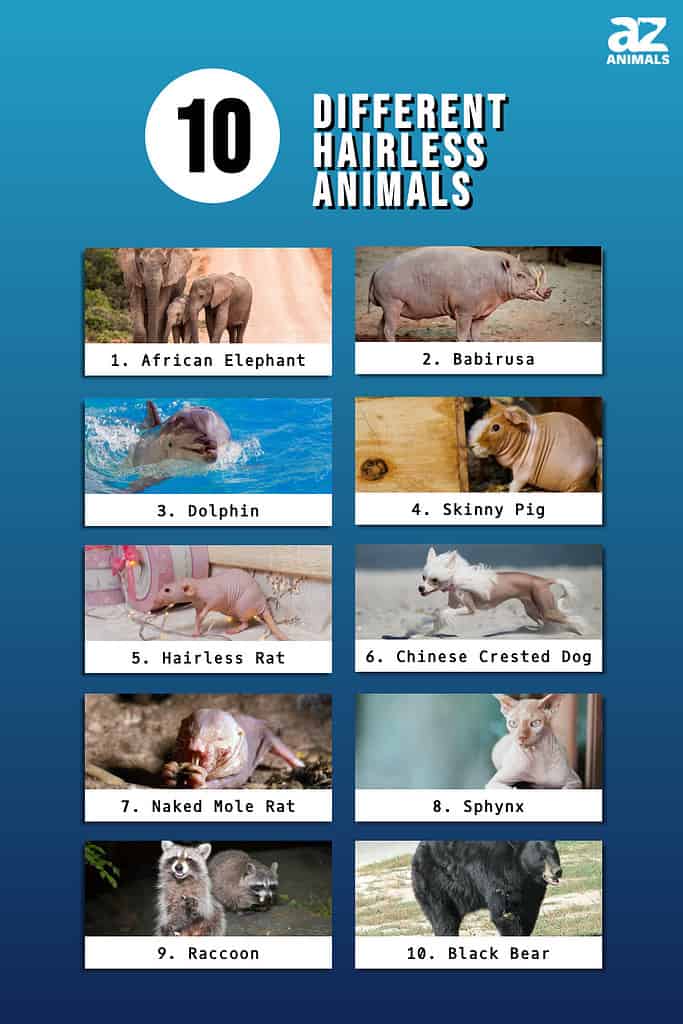
There are over 5,000 species of mammal on the planet, and they cover an array of creatures as diverse as the 100-foot long blue whale, Australia’s oddly duck-like platypus, and the fiercely armored pangolin. But there are a few things that are common among all mammals — most notably their warm-blooded metabolism, four-chambered hearts, complex brains, and the presence of hair. Hair or fur developed primarily as a way of insulating mammals against cold. It’s a practical necessity that helps with the already challenging task of self-regulating body temperature.
For some animals, hair is either absent or so sparse as to be unnoticeable to the casual observer. This could be due to a skin condition, natural selection, or even directed breeding to create bald animals for use as pets. Odd looking animals have always drawn attention and they often become a popular fad. Whether it is lack of hair or smushed noses or comically short legs, these traits always have a high price to pay in health issues and pain. unfortunately, breeding for such extremes has always been profitable to the breeders while the animals pay the price.
Each of these hairless animals has a story to tell, and here are the facts behind 10 of the most fascinating hairless animals in the world.
1. Black Bears: The Mystery at Leipzig Zoo
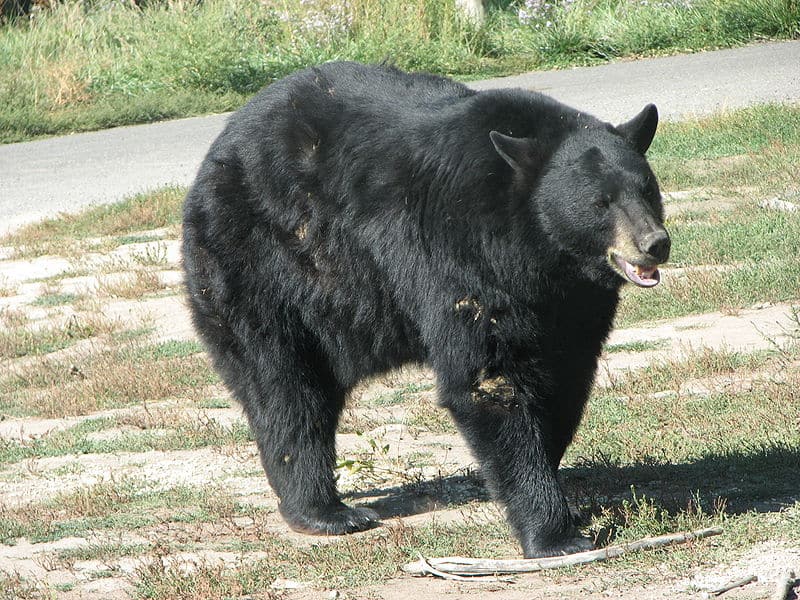
An outbreak of sarcoptic mange is affecting
black bears
throughout the
American
Northeast and Mid-Atlantic.
©cs: User: DaBler, CC BY-SA 3.0, via Wikimedia Commons – License
When the three female spectacled bears at Leipzig Zoo in Germany began to lose their hair and show both lesions and rashes on their skin, zoologists and caretakers were at a loss. None of the males exhibited similar conditions, and the two primary causes for hair loss in bears — mange and alopecia — didn’t appear to be to blame. It’s a mystery that was never solved, but bears going bald appears to be only growing in scale and severity. An outbreak of sarcoptic mange is affecting black bears throughout the American Northeast and Mid-Atlantic, and it’s a condition that can cause not just hair loss but also a fatal autoimmune deficiency. Polar bears have similarly seen an uptick in cases of baldness-causing alopecia, and the prevailing notion seems to believe it could be a result of declining health due to climate change destroying their habitats.
2. Raccoons: Common Victims of Mange
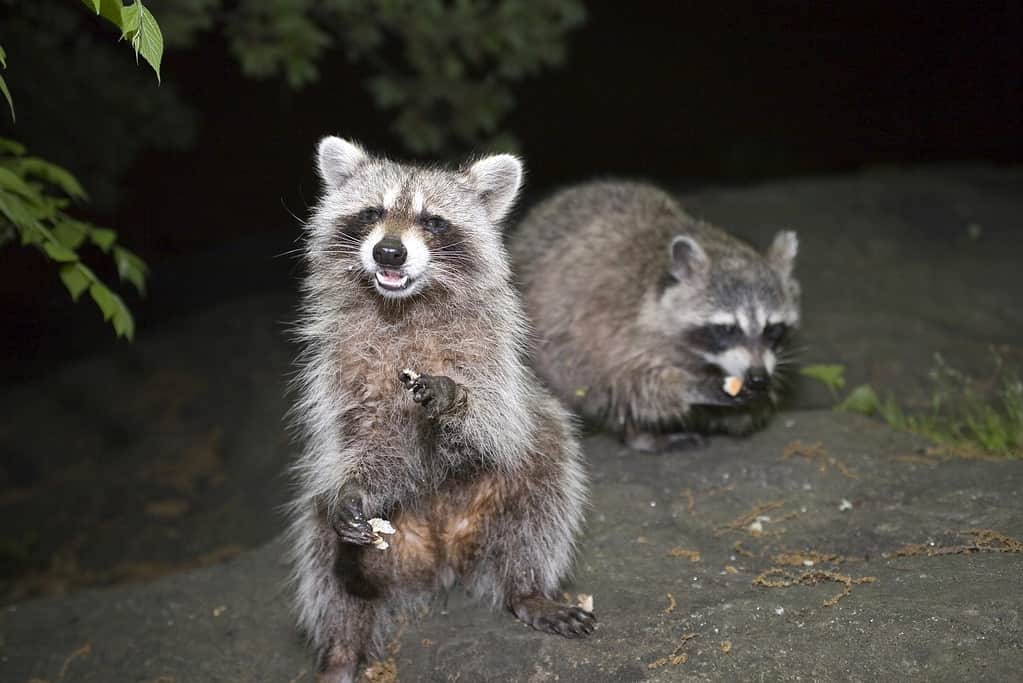
Because raccoons often coexist near human settlements means people are more likely to encounter them than other hairless animals.
©iStock.com/eddtoro
When a strong, hairless six-pound creature was discovered in a Florida suburb, its appearance was so bizarre and unprecedented that some whispered that it might be the legendary Mexican cryptid known as a chupacabra. Without the trademark shape, patterns, and coloration of its fur, a casual observer would likely never guess that the animal was a raccoon. And while this raccoon — dubbed Dobbie after the Harry Potter character — unfortunately didn’t survive its encounter with sarcoptic mange, a similarly bald raccoon named Gizmo recovered from its encounter and healed up after being given treatment in 2018.
Mange isn’t necessarily more common in raccoons than in other wild animals, but the fact that they often coexist on the edge of human settlements means people are more likely to encounter them than many other hairless animals. A study published as recently as 2021 indicated that the spread of mange might be facilitated by climate change since hairless animals like raccoons can survive longer in warmer weather and can thus pass the condition more easily.
3. Sphynx: The Egyptian Cat Bred to Be Bald
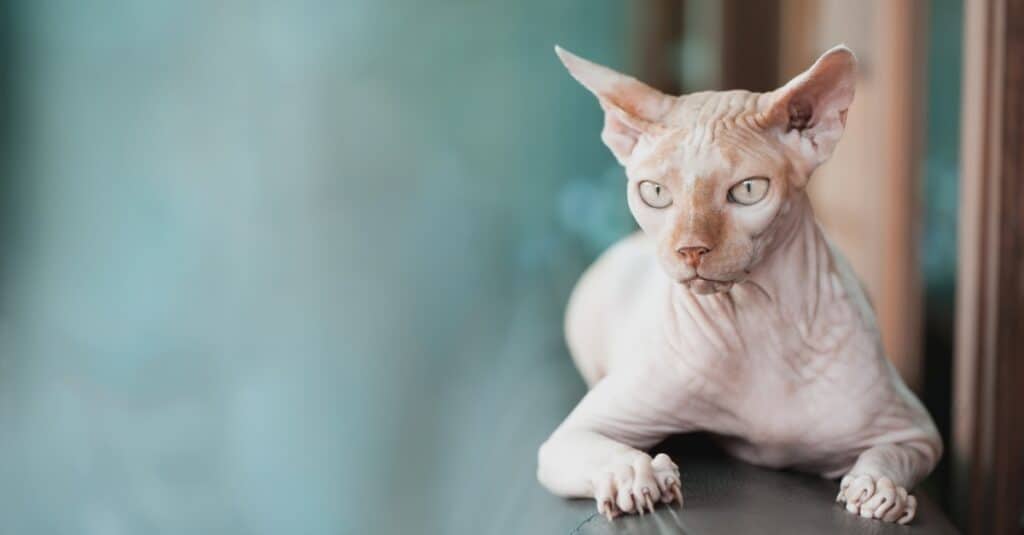
©iStock.com/Natalie_magic
One of the most well-known hairless animals, the hairless Sphynx cat has a surprising resemblance to the felines that decorated the tombs of Egyptian pharaohs, its origins are far less exotic and far more recent. The first sphynx was created in Canada in 1966 by breeding a domestic shorthair with a kitten that had a genetic mutation causing baldness. Though not the first hairless cat, this is the first to be bred with the explicit intent of being born without fur. Sphynxes are born without fur, but the genetic makeup of the breed can sometimes lead to cats who have a coat. While not usually kept as pets, they’re often still used for breeding diversity.
4. Naked Mole Rat: Bald and Truly Bizarre

©Neil Bromhall/Shutterstock.com
The fact that it’s born without fur might not be the most unusual feature of the naked mole-rat. Found throughout Somalia, Ethiopia, and Kenya, these rodents are almost completely blind and deaf, and they forage for their vegetarian meals in expansive colonies underground. These colonies can house as many as 300 of the creatures, and these communities are important because it allows them to bundle together to produce body heat — a necessity considering their lack of body hair. Like most naturally bald animals, naked mole rats aren’t entirely without fur or hair. These include whiskers for blindly navigating their underground burrows and hairs between their toes to assist with digging.
5. Chinese Crested Dog: A Hairless Breed With a Storied Lineage

©iStock.com/Bigandt_Photography
The Chinese crested dog isn’t completely bald, but the tufts of hair on its feet, tail, and head only enhance the oddness of its otherwise naked body. Thanks to the recessive genetic trait that causes this condition, both furred and hairless puppies can appear within the same litter. As smaller dogs, they’re a great choice for smaller homes like apartments — and as a hairless dog, they make sense for people who are worried about a dog causing their allergies to act up. Their fragile appearance reflects the fact that they often need caretakers with a gentle touch, but they’re personable and mischievous dogs who are known to bond tightly with just one person at the expense of everyone else.
6. Hairless Rat: A Cautionary Tale in Breeding Unique Animals as Pets
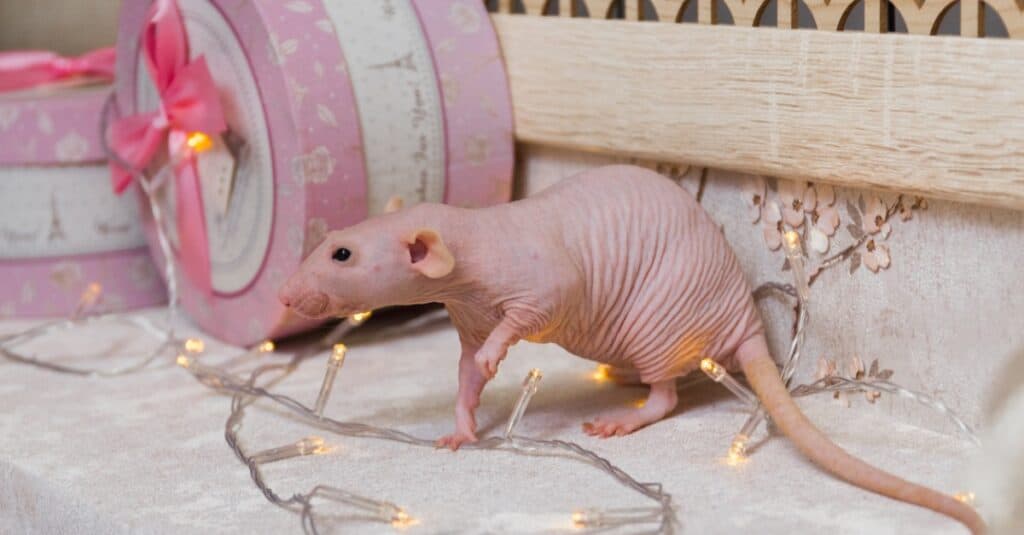
©iStock.com/Elena Neveditsyna
In terms of speciation, hairless rats are simply a variation of fancy rat that has a genetic mutation that prevents the thymus gland from properly growing. These hairless animals are born with hair, but their faulty immune systems cause them to lose it shortly after birth. While these rats are sometimes referred to as sphynx rats and intentionally bred to be used as pets — the major health effects of their genetic deficiency make the process both difficult and ethically dubious.
Researchers use these rats for lab testing and are finding out that they could reveal key knowledge into important medical research. Their lack of fur makes them ideal candidates for research into how wounds heal. Unfortunately, the health issues of this species mean that they rarely last longer than a year.
7. Skinny Pig: A Random Mutation Becomes a Pet Fad
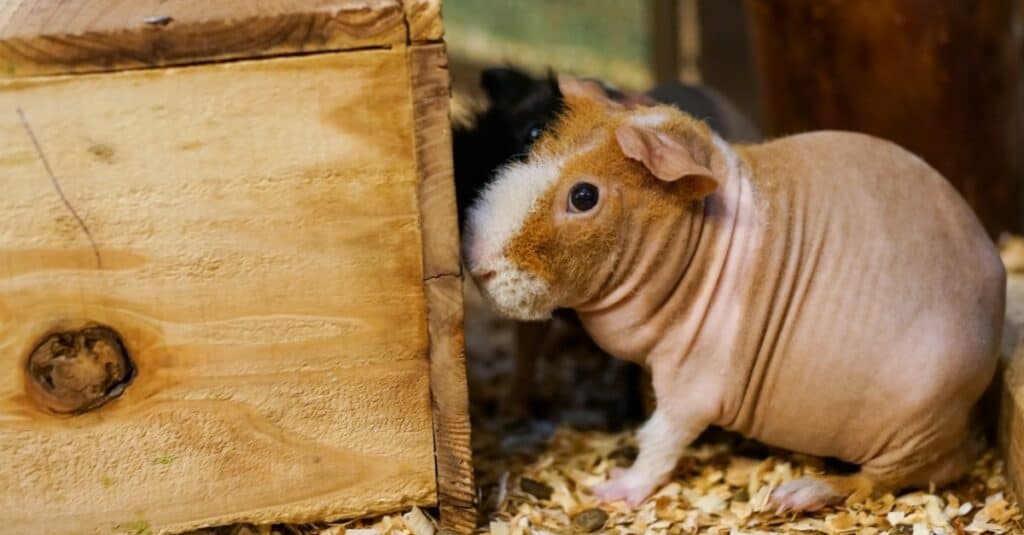
©LeeSensei/Shutterstock.com
Created by scientists by breeding together haired and hairless species of Guinea pigs in 1978, the skinny pig has since become a popular pet in both Europe and North America. Since this is caused merely by a recessive gene without any notable health complications, breeding is both easier and significantly more ethical than breeding hairless rats as pets. And if you know how to care for a guinea pig, you should have to make few — if any — adjustments to your habits. Skinny pigs have the same personalities and habits as their more furry cousins, and they aren’t entirely hairless. Small patches of fur appear on their feet, legs, and noses.
8. Dolphin: A Result of Reversion Via Natural Selection

©Lefteris Papaulakis/Shutterstock.com
Hair first appeared in mammals about 300 million years ago — but 30 million years ago, the descendants of dolphins retreated into the water and lost the need for hair. They aren’t the only ones either. Whales and porpoises share the same branch in the dolphin’s evolutionary tree — while the descendants of these mammals who stayed on land kept their hair and eventually evolved into hippos, cows, giraffes, and more. These underwater mammals are all known as cetaceans, and they’ve developed an extra layer of blubber to compensate for a lack of fur. It’s a natural evolution that helps control their body heat while not hindering their ability to navigate through water. Despite this, you can still see the telltale sign of hairs on the chins of newborn dolphins.
9. Babirusa: The Strange, Hairless Deer-Pig
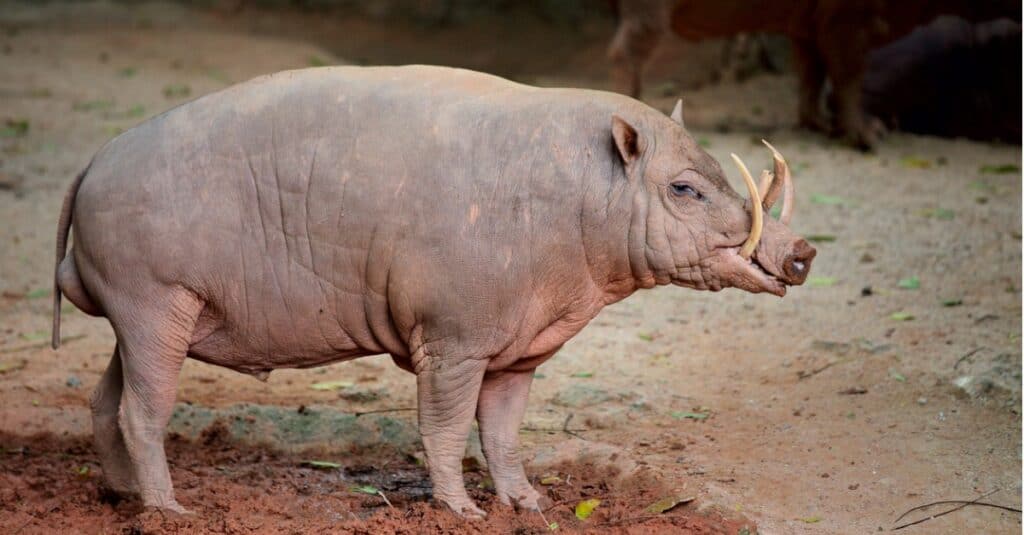
©iStock.com/leungchopan
Current research suggests that pigs — of which the wild babirusa is a member — might be the second closest terrestrial relatives to the dolphin after hippos. But there’s no doubt that these animals lost their hairs long after their aquatic counterparts. Despite that, the reasons seem to be largely similar. It appears that they instead developed extra fat layers to better insulate them against heat, and they also roll in mud to help regulate their temperature much like other pigs. But the babirusa’s most unusual feature is its imposing tusks which have earned it the moniker of “deer-pig”. The prevailing theory is that these tusks were developed not as a weapon but as a defense to protect the face of males.
10. African Elephant: Made Bald by Environmental Necessity

©iStock.com/WillieErasmus
The frequently brutal temperatures of the African grasslands are likely the primary reason why its elephants lost their hair. The huge surface area on their tremendous bodies makes them especially prone to overheating under the direct heat of the open plains. It’s a theory that is further supported by the fact that Asian elephants have significantly more hair on their bodies to suit their more mild climates. Heat dissipation is also a reason why the ears of African elephants are significantly larger than their Asian counterparts.
Scientists have long puzzled over why African elephants still have patches of thin hair, most notably on their heads. The strategic and infrequent dispersal of these hairs has the opposite effect of a typical mammal’s fur by distributing heat evenly throughout the body and into the air rather than serving as insulation. It’s a seemingly small example of natural selection, but it can help keep these giant mammals up to 25% cooler on the aridest days.
Summary of 10 Different Hairless Animals
Lack of hair is the result of natural selection, a symptom of a health issue, or deliberate breeding for that trait. These are the ten most common hairless traits:
| Number | Species | Reason for Hairlessness |
|---|---|---|
| 1. | African Elephant | Environmental adaptation |
| 2. | Babirusa | Environmental adaptation |
| 3. | Dolphin | Environmental adaptation |
| 4. | Skinny Pig | Man-made mutation |
| 5. | Hairless Rat | Man-made mutation |
| 6. | Chinese Crested Dog | Man-made mutation |
| 7. | Naked Mole Rat | Environmental adaptation |
| 8. | Sphynx | Man-made mutation |
| 9. | Raccoons | Symptom of disease |
| 10. | Black bears | Symptom of disease |
The photo featured at the top of this post is © iStock.com/ElenaBoronina
Thank you for reading! Have some feedback for us? Contact the AZ Animals editorial team.






